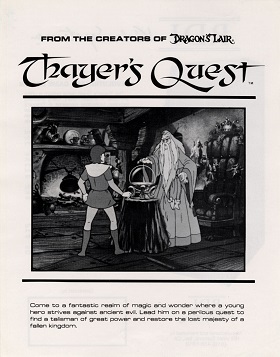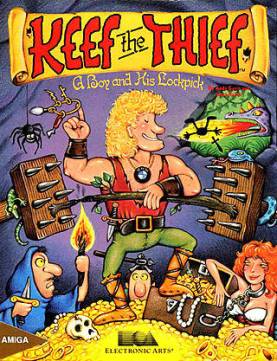
Arkanoid is a 1986 block breaker arcade game developed and published by Taito. In North America, it was published by Romstar. Controlling a paddle-like craft known as the Vaus, the player is tasked with clearing a formation of colorful blocks by deflecting a ball towards it without letting the ball leave the bottom edge of the playfield. Some blocks contain power-ups that have various effects, such as increasing the length of the Vaus, creating several additional balls, or equipping the Vaus with cannons. Other blocks may be indestructible or require multiple hits to break.

Wonder Boy in Monster Land, known by its original arcade release as Wonder Boy: Monster Land, is a platform video game developed by Westone Bit Entertainment and released by Sega in Japanese arcades in 1987 and for the Master System in 1988, with a number of other home computer and console ports following. The game is the sequel to the 1986 game Wonder Boy and takes place eleven years after the events in the previous game. After enjoying over a decade of peace on Wonder Land following the defeat of the evil King by Tom-Tom, later bestowed the title "Wonder Boy", a fire-breathing dragon called the MEKA dragon appeared; he and his minions conquered Wonder Land, turning it into "Monster Land". The people, helpless due to their lack of fighting skill, call for Wonder Boy, now a teenager, to destroy the monsters and defeat the MEKA dragon. Players control Wonder Boy through twelve linear levels as he makes his way through Monster Land to find and defeat the MEKA dragon. Players earn gold by defeating enemies and buy weapons, armor, footwear, magic, and other items to help along the way.

Bad Dudes Vs. DragonNinja, also known simply as either Bad Dudes or DragonNinja, is a side-scrolling cooperative beat 'em up game developed and released by Data East for arcades in 1988. It was also ported to many computer and game console home systems.

Sid Meier's Pirates! is a video game created by Sid Meier for the Commodore 64 and published by MicroProse in 1987. It was the first game to include the name "Sid Meier" in its title as an effort by MicroProse to attract fans of Meier's earlier games, most of which were combat vehicle simulation video games. The game is a simulation of the life of a pirate, a privateer, or a pirate hunter in the 16th, 17th and 18th centuries. It was widely ported to other systems.

Space Ace is a LaserDisc video game produced by Bluth Group, Cinematronics and Advanced Microcomputer Systems. It was unveiled in October 1983, just four months after the Dragon's Lair game, followed by a limited release in December 1983 and then a wide release in Spring 1984. Like its predecessor, it featured film-quality animation played back from a LaserDisc.
An interactive film is a video game or other interactive media that has characteristics of a cinematic film. In the video game industry, the term refers to a movie game, a video game that presents its gameplay in a cinematic, scripted manner, often through the use of full-motion video of either animated or live-action footage.

Silpheed is a video game developed by Game Arts and designed by Takeshi Miyaji. It made its debut on the Japanese PC-8801 in 1986, and was ported to the Fujitsu FM-7 and DOS formats soon after. It was later remade for the Sega CD and has a sequel called Silpheed: The Lost Planet for the PlayStation 2.

Total Carnage is a multidirectional shooter arcade video game originally developed and published by Midway in North America in January 1992. Set in the fictional country of Kookistan during 1999, players assume the role of Captain Carnage and Major Mayhem from the Doomsday Squad in a last-ditch effort to overthrow dictator General Akhboob and his army of mutants from conquering the world, while also rescuing POWs held by his military force.

Double Dragon is a 1987 beat 'em up video game developed by Technōs Japan and distributed by Taito for arcades across Asia, North America and Europe. It is the first title in the Double Dragon franchise. The game's development was led by Yoshihisa Kishimoto, and it is a spiritual and technological successor to Technos' earlier beat 'em up, Nekketsu Kōha Kunio-kun (1986), released outside of Japan by Taito as Renegade; Kishimoto originally envisioned it as a direct sequel and part of the Kunio-kun series, before making it a new game with a different cast and setting.

Dragon Spirit is a 1987 vertical-scrolling shooter arcade game developed and published by Namco. In North America, it was distributed by Atari Games. Controlling the dragon Amul, the player must complete each of the game's nine areas to rescue the princess Alicia from the demon Zawell. Similar to Namco's own Xevious, Amul has a projectile weapon for destroying air-based enemies and a bomb for destroying ground enemies. It ran on the Namco System 1 arcade board.

Thayer's Quest is a LaserDisc video game initially developed by RDI Video Systems in 1984 for their unreleased Halcyon console, and later released in arcades as a conversion kit for Dragon's Lair and Space Ace. In 1995 it was ported to home consoles and PC under the title Kingdom: The Far Reaches. The arcade machine had a membrane keypad for controls instead of a joystick. To help players learn the daunting—for an arcade game—controls, a small holder containing instructional leaflets was attached to the cabinet. A sequel, Kingdom II: Shadoan, was released in 1996.
Digital Leisure, Inc. is a Canadian publisher of software. The company formed in 1997 with the aim to acquire, remaster and publish numerous classic video-based arcade games such as the Don Bluth-animated titles Dragon's Lair, Dragon's Lair II: Time Warp and Space Ace. Over time, they have acquired the publishing rights to various full motion video games, which they have re-released on a variety of modern formats. In more recent years, they have produced original games as well.

Dragon's Lair 3D: Return to the Lair is an action-adventure game released in 2002 by Ubisoft. It is based on 1983 arcade video game Dragon's Lair and follows a similar story: Dirk the Daring must enter the evil wizard Mordroc's castle to rescue Princess Daphne from Singe the Dragon. Many of the characters and locations from the 1983 original make appearances in the game, along with new puzzles, rooms and enemies. Animator and director Don Bluth, who produced the cartoon animation for the original Dragon's Lair, produced new animated sequences for the opening and ending of the game. The game uses cel shading to mimic the style of the hand-drawn art of 1983 game.

Escape from Singe's Castle, also known as Dragon's Lair Part II - Escape From Singe's Castle, is a computer game for the Amstrad CPC, Commodore 64 and ZX Spectrum home computers, released by Software Projects in 1987.

Keef the Thief: A Boy and His Lockpick is a video game developed by Naughty Dog and published by Electronic Arts. It was released in 1989 for the Apple IIGS and then later ported to the Amiga and MS-DOS. Keef the Thief is a comedic sword and sorcery role-playing game.

Dragon's Lair is an interactive film LaserDisc video game developed by Advanced Microcomputer Systems and published by Cinematronics in 1983, as the first game in the Dragon's Lair series. In the game, the protagonist Dirk the Daring is a knight attempting to rescue Princess Daphne from the evil dragon Singe who has locked the princess in the foul wizard Mordroc's castle. It featured animation by ex-Disney animator Don Bluth.
Dragon's Lair is a video game franchise created by Rick Dyer. The series is famous for its Western animation-style graphics and complex decades-long history of being ported to many platforms and being remade into television and comic book series.

Dragon's Lair III: The Curse of Mordread is a video game in the Dragon's Lair series, developed by Don Bluth Multimedia and published by ReadySoft Incorporated for the Amiga, Atari ST and MS-DOS in 1993. An Apple IIGS port was released in 2022.

Dragon's Lair is an action game developed by Digital Eclipse and published by Capcom for the Game Boy Color handheld game console. It released on January 15, 2001 in North America and August 24, 2001 in Europe. It is a version of the arcade original of the same name. Like the original, players control protagonist Dirk the Daring who is tasked with rescuing Princess Daphne. In doing so, players must avoid various obstacles and foes using quick reaction inputs to get from one scene to another. If an action command is failed, Dirk loses a life.
















